Fiber Span FS31H-4 BOOSTER User Manual FS31H 4X USR
Fiber-Span LLC BOOSTER FS31H 4X USR
Users Manual

FS31H-4X-USR
User Manual
UHF Headend Repeater Unit

UHF Headend Repeater Unit
User Manual Ver. A
Document ID: FS31H-4X -USR Page 2 of 32
This page was left intentionally blank
Page 2 of 30
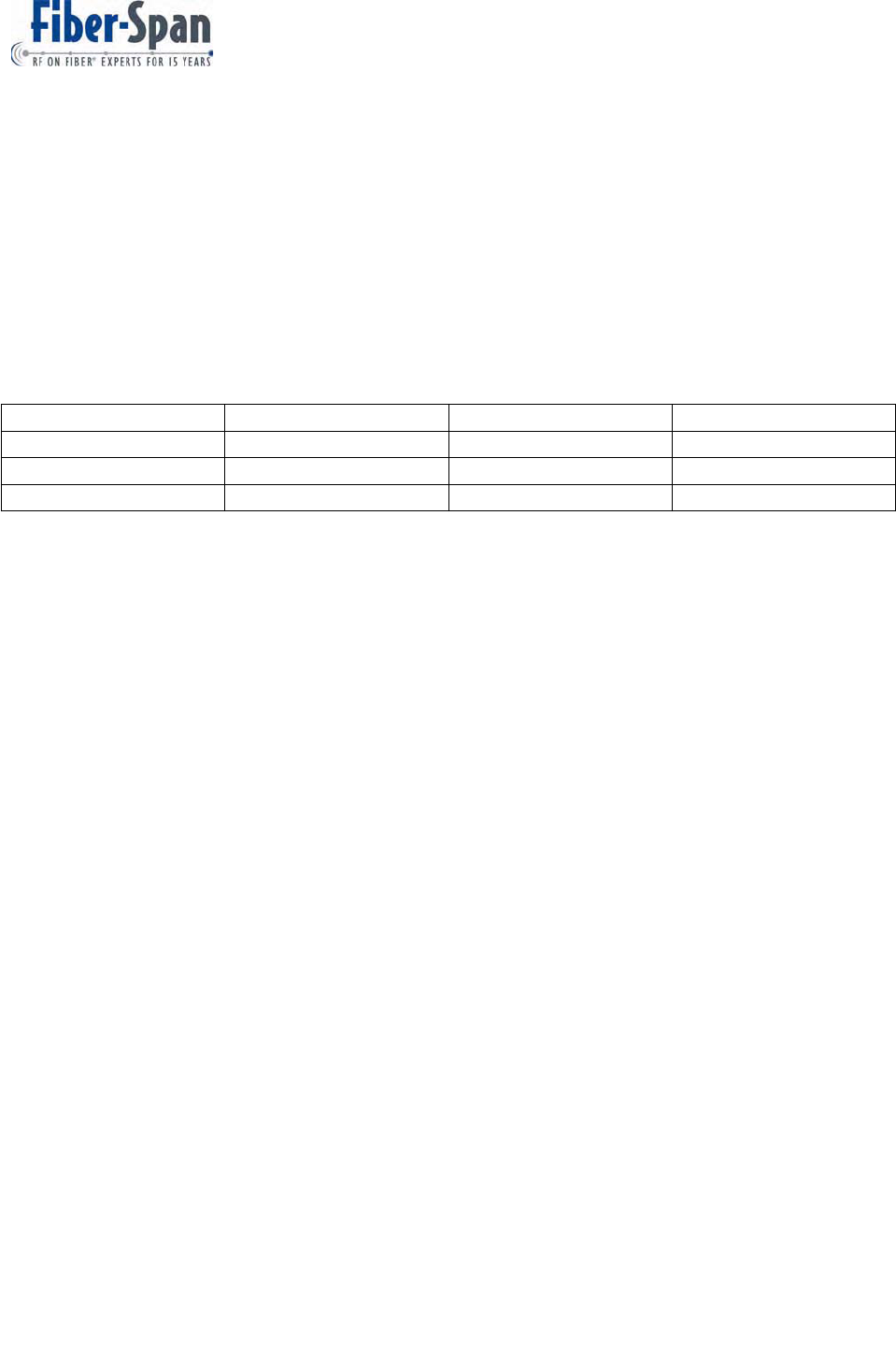
UHF Headend Repeater Unit
User Manual Ver. A
Document ID: FS31H-4X -USR Page 3 of 32
Version A
Information in this document is subject to change without notice.
All rights reserved.
Please send comments to:
E-mail: infotech@Fiber-Span.com
Phone: 908-754-0646
Fax: 908-754-0647
Revision History
Version Author Description Date
A DK/CM April 28, 2008
Page 3 of 29

UHF Headend Repeater Unit
User Manual Ver. A
Document ID: FS31H-4X -USR Page 4 of 32
Table of Contents
1.0 Company Info .......................................................................................................... 5
2.0 Product Intro............................................................................................................ 6
2.1 HRU Description..................................................................................................................6
2.2 Theory of Operation (Gain and Power Output)....................................................................7
2.3 Product Applications............................................................................................................8
3.0 Detailed Description.............................................................................................. 12
3.1 Amps .................................................................................................................................12
3.2 Duplexers ..........................................................................................................................14
3.3 Alarm Motherboard............................................................................................................15
3.4 Power Supply ....................................................................................................................17
3.5 Specifications ....................................................................................................................17
4.0 Setup Procedure ................................................................................................... 19
4.1 Cautionary Notes...............................................................................................................19
4.2 Contents ............................................................................................................................19
4.3 Downlink Setup .................................................................................................................21
4.4 Uplink Setup ......................................................................................................................23
4.5 De-rating Table..................................................................................................................24
4.6 Power Amp ALC Threshold Setup....................................................................................24
4.7 Power Amp Forward Power Output Alarm Threshold Setting ...........................................25
5.0 Installation Procedures......................................................................................... 27
5.1 Connectorization ...............................................................................................................27
5.2 Grounding..........................................................................................................................27
5.3 Adequate Anchors required...............................................................................................28
6.0 Troubleshooting.................................................................................................... 30
6.1 Power LED Light ...............................................................................................................31
6.2 Door Lights ........................................................................................................................31
6.3 Amplifier Alarms ................................................................................................................31
6.4 Fan Blockage ....................................................................................................................31
7.0 Warranty Information............................................................................................ 32
7.1 Warranty Limitations..........................................................................................................32
7.2 Limitations of Damages.....................................................................................................32
7.3 Return Material Authorization (RMA).................................................................................32
Page 4 of 29
30

UHF Headend Repeater Unit
User Manual Ver. A
Document ID: FS31H-4X -USR Page 5 of 32
1.0 Company Info
Fiber-Span is a premier provider of advanced RF ON FIBER ® technologies and solutions for
fiber optic based transmission of high fidelity radio-frequency wireless voice, data and
multiservice networking applications. Fiber-Span's proprietary RF/Fiber Optic transceivers,
transmitters and receivers are rugged, compact OEM modules and subsystems designed for
easy integration into commercial cellular, GSM, PCS/PCN, M/LMDS, WLL, IF, satellite terminal
or distinctive antenna system configurations. Fiber-Span is addressing public safety needs by
providing fiber optic wireless solutions for police, fire, emergency, first responder and Homeland
Security radio systems applications. Fiber-Span's solutions for Defense and Military
organizations are also leading the way by providing reliable and secure communications links
for ground, airborne, shipboard, radar, telemetry, GPS and intelligence solutions in the
HF/UHF/VHF and microwave radio frequencies. Fiber-Span's evolving class of product
addresses the growing demand and movement toward the convergence of wire line and
wireless networks, and the requirement for high performance, high bandwidth RF ON FIBER ®
solutions and networks. Fiber-Span's customers are global wireless communication systems
original equipment manufacturers (OEM), radio frequency (RF) system integrators, and military
system architects. More information about Fiber-Span products is available from the contact info
listed below.
Fiber-Span
111 Corporate Boulevard,
South Plainsfield, NJ 07080
Email: techinfo@fiber-span.com
Web: http://www.fiber-span.com/
Page 5 of 29
30
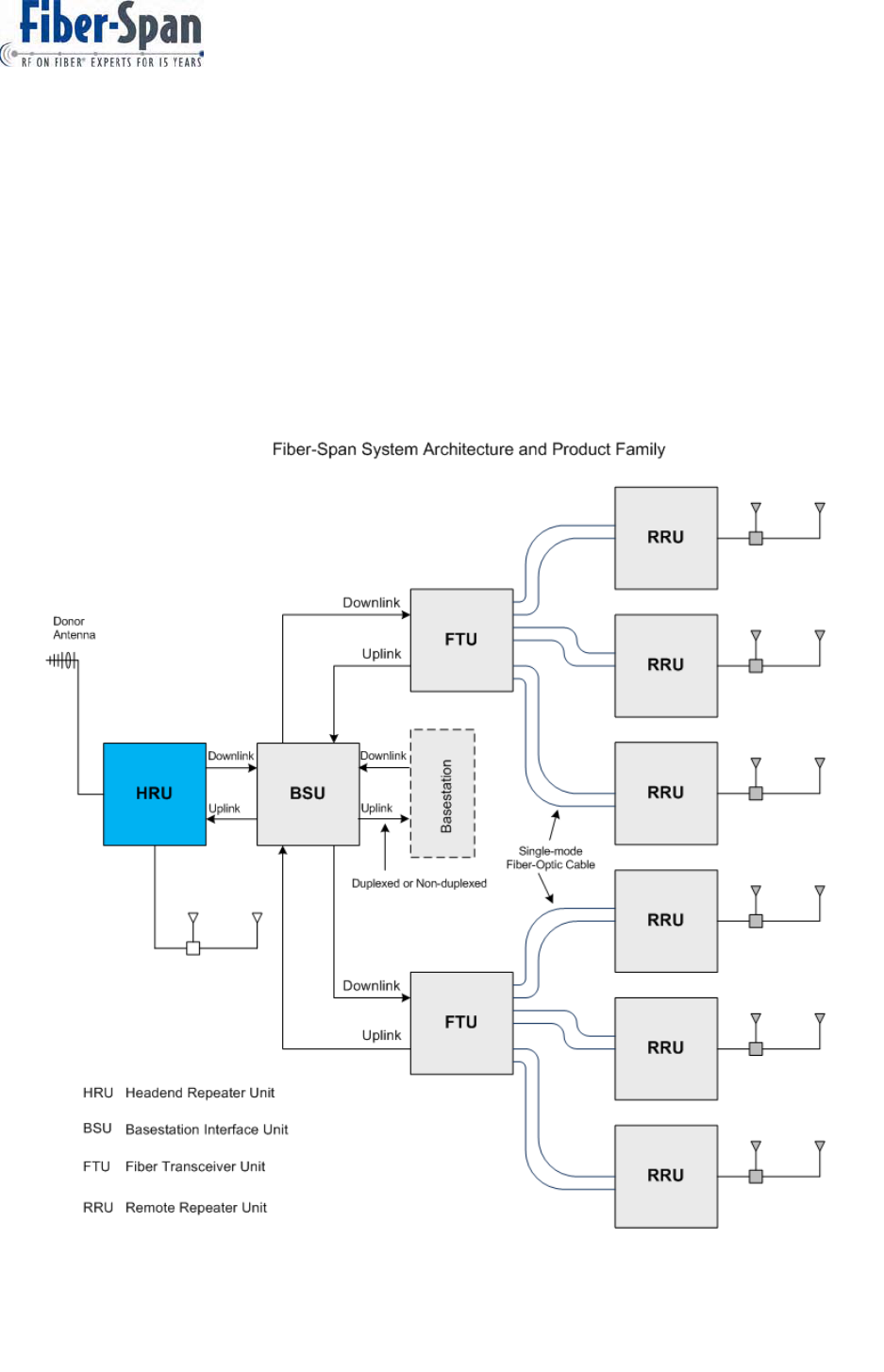
UHF Headend Repeater Unit
User Manual Ver. A
Document ID: FS31H-4X -USR Page 6 of 32
2.0 Product Introduction
This manual covers the Headend Repeater Unit (HRU). Most applications for simple coverage
enhancement solutions would require a Bi-Directional Amplifier (BDA). The HRU is Fiber-
Span’s equivalent technology to the BDA. The HRU has additional hardware that allows a
direct connection to fiber-optic transceivers.
2.1 HRU Description
The HRU is the interface to the donor antenna and is located at the Headend of any in-building
coverage solution. The following diagram illustrates how the HRU fits into the Fiber-Span
system architecture.
Page 6 of 29
30
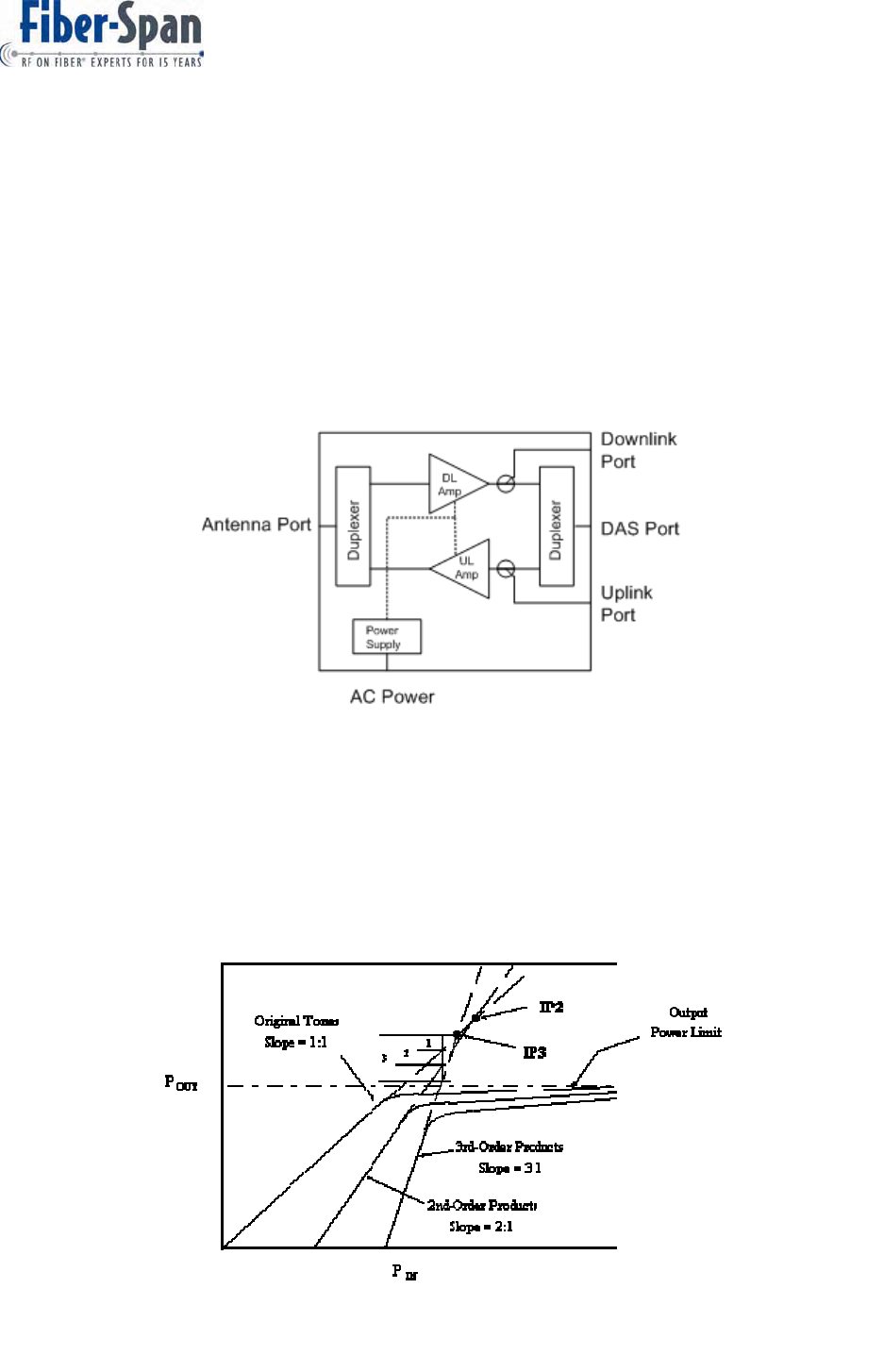
UHF Headend Repeater Unit
User Manual Ver. A
Document ID: FS31H-4X -USR Page 7 of 32
The HRU amplifies RF frequencies in both the downlink and uplink paths with duplexers that
provide both downlink and uplink frequency bands on a single distributed antenna system. The
HRU is used to provide cost efficient wireless coverage in areas that have poor coverage.
Fiber-span has additional unique hardware in the HRU that allows it to feed fiber-optic
transceivers (FTU). This is the main difference between the HRU and a typical BDA. The
downlink port is tapped off the output of the downlink amplifier. The uplink frequencies are
combined prior to amplification in the uplink amplifier. The separate downlink and uplink ports
are present on the bottom of the unit along with the antenna port and a DAS port. The following
block diagram better illustrates how the HRU is configured.
2.2 Theory of Operation (Gain and Power Output)
The amplifiers used in the BDA provide a set amount of gain. Gain is defined as the ratio in the
amount of RF power of the output and input of the amplifier. If +20dBm of RF power is required
at the DAS port and -50dBm is measured at the antenna port, the gain must be set to 70dB.
Page 7 of 29
30

UHF Headend Repeater Unit
User Manual Ver. A
Document ID: FS31H-4X -USR Page 8 of 32
When multiple RF carriers are input to an RF amplifier, the RF output power will be the input
power plus the gain.
Power output = Power input + Gain (in decibels)
Power output = Power input x Gain (in Watts)
As seen by the preceding figure, the output power tracks the input power linearly. Eventually as
the input power increases, the amplifier output power reaches the output power limit. When this
happens, intermodulation products are generated at the amplifier output. The intermodulation
products with the most likelihood of generation are 2
nd
and 3
rd
order. For every 1dB increase in
input RF power, the 3
rd
order intermodulation products increase 3dB. If one were to plot the 3
rd
order output power on a graph as in the preceding figure, the slope of the 3
rd
order products
would intersect the line of the output power plotted vs. the input power. This point is defined as
the 3
rd
order intercept and is used by amplifier manufacturers to characterize the maximum
output power of an RF amplifier.
The RF output power of the amplifiers is defined as the total RF output power inside the
bandwidth of the duplexers. This RF output power is divided into the number of dominant RF
carriers at the output of the amplifier.
2.3 Product Applications
The HRU has several purposes.
x As a single unit to provide coverage for a single band of wireless service;
x As multiple units amplifying coverage for multiple services;
x As an amplifier to feed fiber-optic transceivers and provide RF wireless coverage using
coaxial cable fed from the HRU.
The following diagrams help illustrate a typical coverage solution for a single band of wireless
service.
Page 8 of 29
30
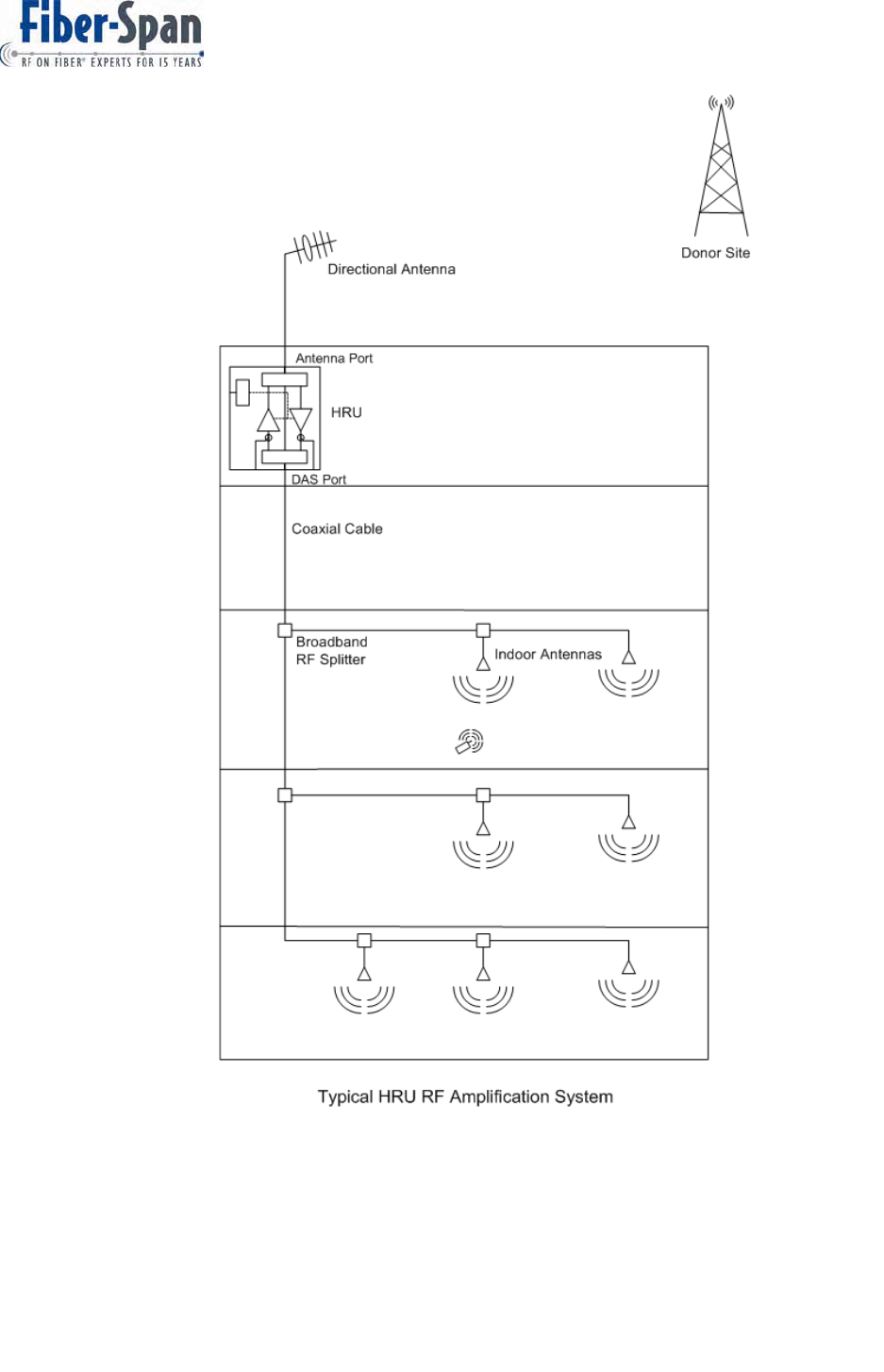
UHF Headend Repeater Unit
User Manual Ver. A
Document ID: FS31H-4X -USR Page 9 of 32
A single band of RF channels is amplified in both directions (downlink and uplink). The RF
channels are then distributed over a single distributed antenna system on floors where coverage
is needed using coaxial cable, RF splitters and indoor ceiling mount antennas.
Page 9 of 29
30
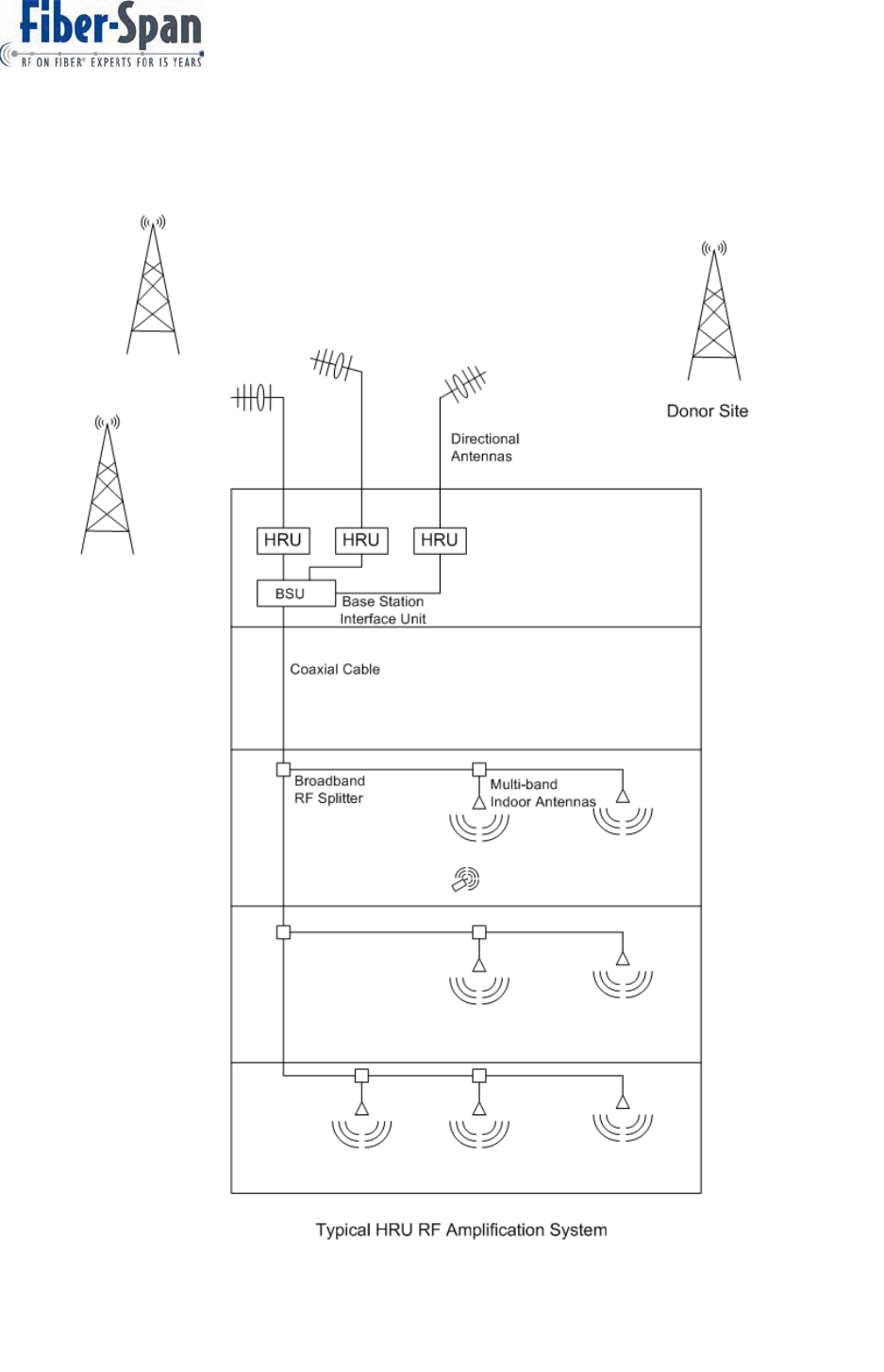
UHF Headend Repeater Unit
User Manual Ver. A
Document ID: FS31H-4X -USR Page 10 of 32
The HRU can provide coverage for multiple wireless services as shown in the following
diagram.
Page 10 of 29
30
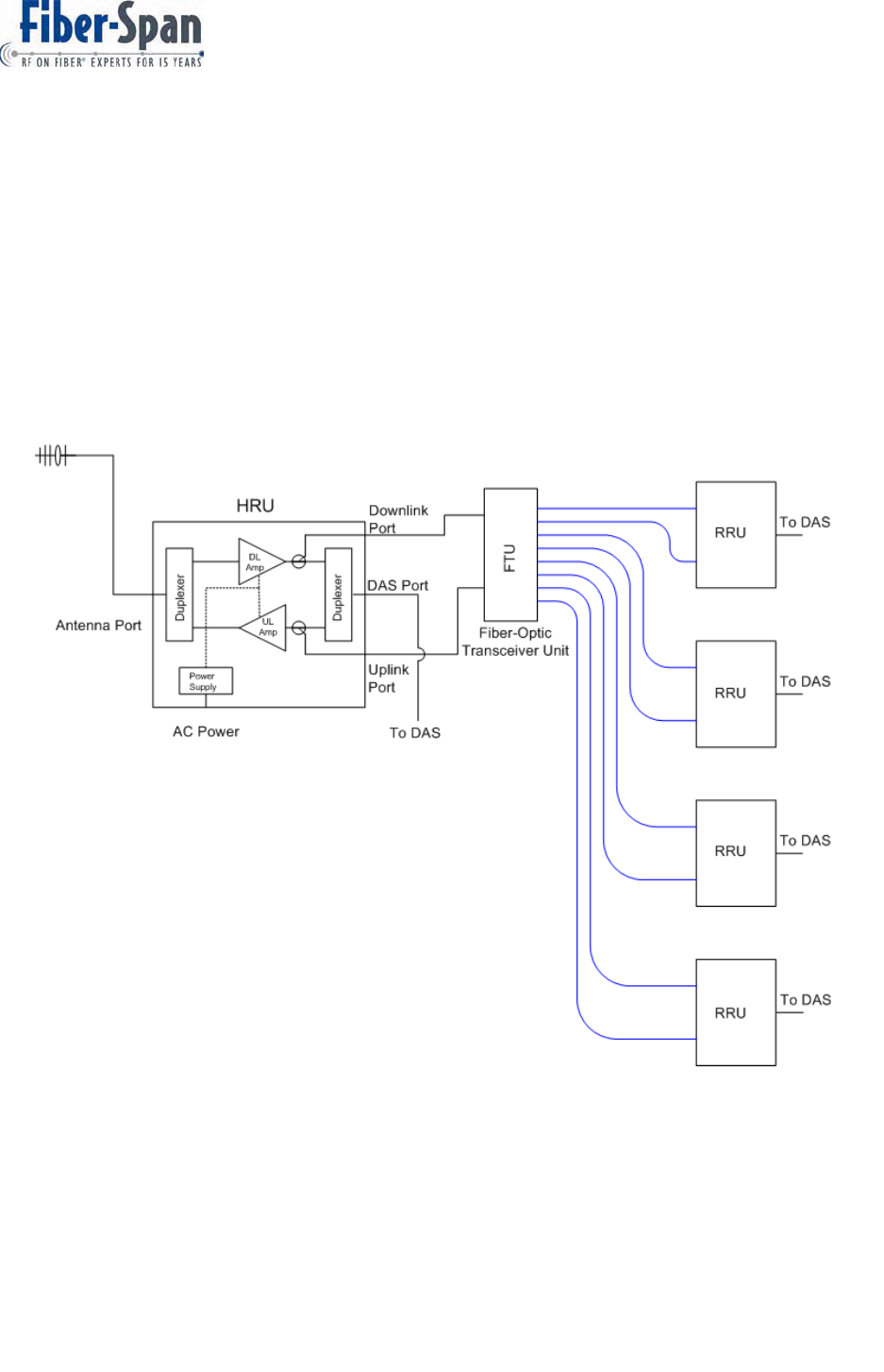
UHF Headend Repeater Unit
User Manual Ver. A
Document ID: FS31H-4X -USR Page 11 of 32
The BSU (Base Station Interface Unit) combines the frequency bands of the wireless services
onto a single common coaxial output. The BSU also provides adequate isolation between the
frequency bands to prevent the possibility of oscillation between two or more HRU’s.
A separate HRU is required for each wireless service because each HRU is capable of
amplifying a single spectrum of channels. For example, one HRU would be need for a UHF
frequency band and a separate HRU would be required for an 800MHz frequency band.
The HRU can also feed fiber-optic transceivers (FTU) which convert the downlink RF signals to
optical signals and convert uplink optical signals to RF signals. The FTU can then feed multiple
RRU’s for coverage over a much wider area. This is illustrated in the following diagram.
In this instance a BSU is not required; however, when multiple HRU’s or FTU’s are required, a
BSU is needed.
For more details on the FTU, BSU and RRU, refer to their respective manuals.
Page 11 of 29
30

UHF Headend Repeater Unit
User Manual Ver. A
Document ID: FS31H-4X -USR Page 12 of 32
3.0 Detailed Description
This section deals with the actual components that are assembled to make up the HRU. The
main subassemblies are:
1. RF Amplifiers – These provide RF signal amplification.
2. Duplexers – These units separate and combine downlink and uplink spectrums and
reduce interference.
3. Alarm Motherboard – This assembly combines alarms and provides a single contact
closure summary alarm.
4. Power Supply – This unit converts the AC power to DC power as required by the active
components.
3.1 Amps
There are two types of amplifiers that Fiber-Span uses to provide the appropriate amount of
gain required to provide coverage solutions:
1. LNA – The LNA (low noise amplifier) is the first amplifier that the RF signal is amplified
by when passing through the HRU. It has a low noise figure to provide an overall lower
noise figure for the entire amplifier.
2. Power Amp – The output power amplifier provides additional gain and has some
additional features like ALC (automatic level control) and pre-distortion.
The amplifiers that Fiber-Span utilizes are powered from a DC power supply. The RF amplifiers
are type A broadband and draw a constant amount of current to set the bias point of the
amplifier.
The power amplifiers employ an Automatic Level Control (ALC) circuit to ensure the RF output
power does not destroy the final gain stage of the RF amplifier. When the ALC circuit is active,
a red light illuminates on the RF amplifier housing. This means the RF output power of the
amplifier has reached the factory set limit and the ALC is reducing the gain to protect the final
gain stage of the amplifier.
The amplifier gain can be reduced to prevent the ALC circuit from becoming active.
The amplifiers also employ a form of pre-distortion to allow multiple channels to operate at
higher levels with reduced intermodulation signal levels. The input RF signal into the amplifier is
pre-distorted such that after amplification, the intermodulation products are reduced from what
would normally be experienced in an amplifier without pre-distortion.
The gain of the HRU is set by adjusting potentiometers in between the LNA and the power
amplifier. Refer to the following block diagram.
Page 12 of 29
30
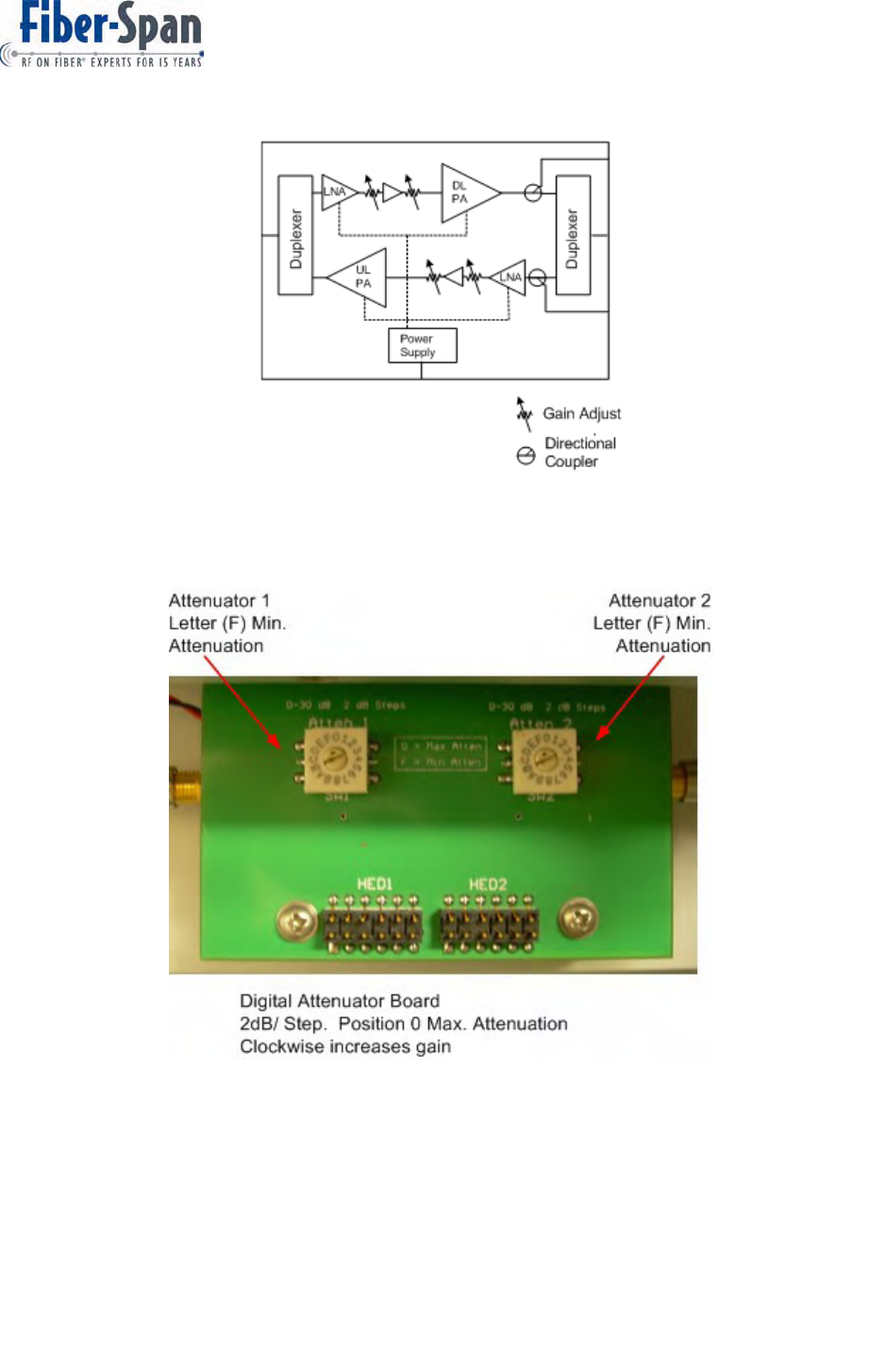
UHF Headend Repeater Unit
User Manual Ver. A
Document ID: FS31H-4X -USR Page 13 of 32
The potentiometers are located inside the HRU cabinet are as shown in the picture below.
Note: Variable Attenuators are not included with Rack-Mount versions of the HRU.
When the dial indicators on each of the potentiometers are pointed towards the letter “F”, the
attenuation is 0dB and the amplifier is at maximum gain. When the potentiometers are rotated
counterclockwise, the gain is reduced by 2dB with every click or incremental change in position.
A small screwdriver is required to adjust the gain settings. The following table summarizes the
amount of attenuation associated with each dial indicator setting.
Page 13 of 29
30
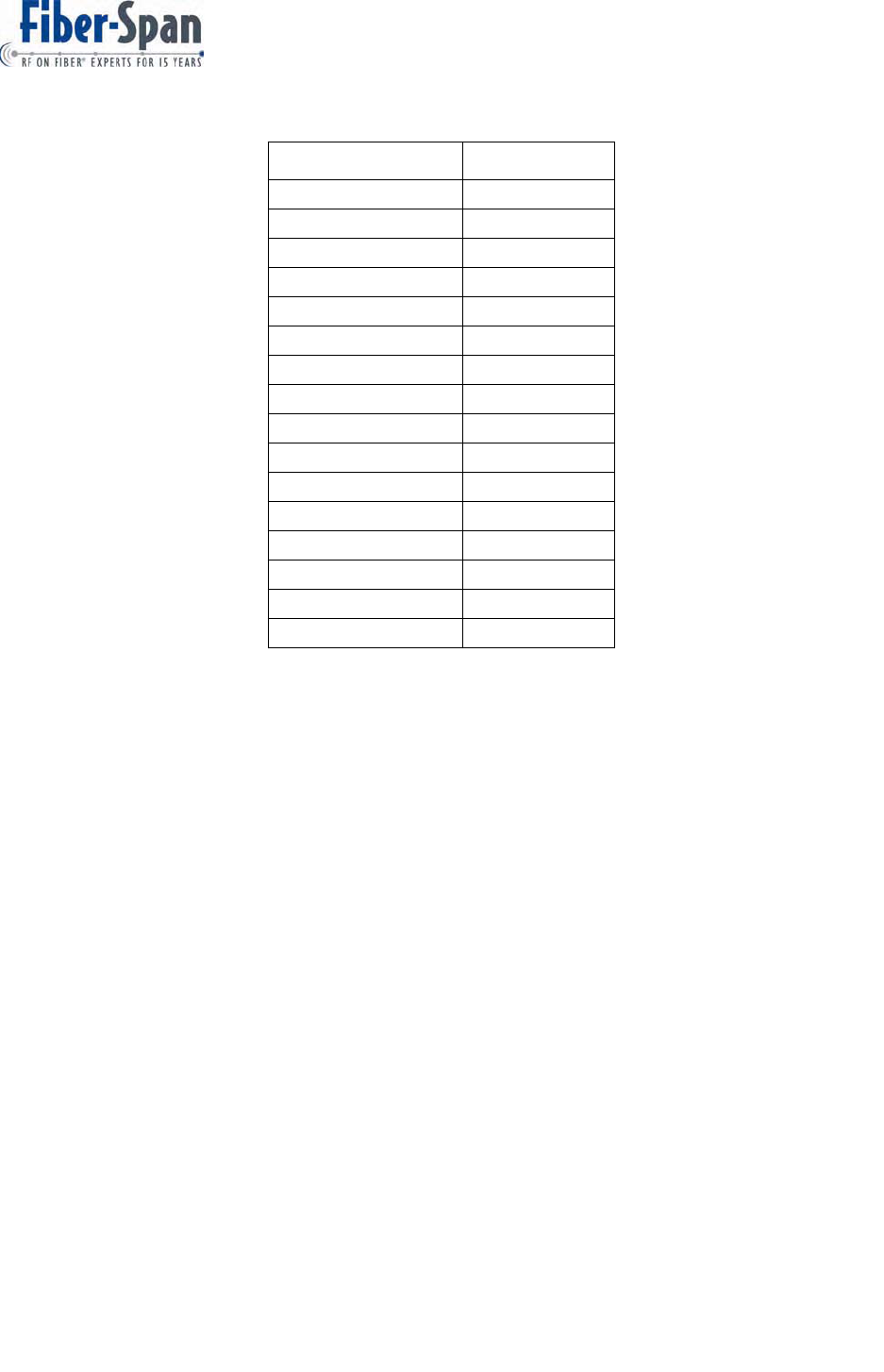
UHF Headend Repeater Unit
User Manual Ver. A
Document ID: FS31H-4X -USR Page 14 of 32
Dial Indicator Attenuation
0 30 dB
1 28 dB
2 26 dB
3 24 dB
4 22 dB
5 20 dB
6 18 dB
7 16 dB
8 14 dB
9 12 dB
A 10 dB
B 8 dB
C 6 dB
D 4 dB
E 2 dB
F 0 dB
For example to provide 20dB or attenuation, one of the potentiometers would be turned towards
the ‘5’ position. Alternatively, both potentiometers can be positioned at the ‘A’ position to
provide 10dB of attenuation each for a total of 20dB.
3.2 Duplexers
The duplexers used in the HRU perform two specific functions:
1. Provide adequate isolation between the downlink and uplink frequency bands to prevent
oscillation; and
2. Provide a suitable bandpass characteristic to prevent unwanted interference from/to
other donor sites in the area.
The amount of isolation required depends on the overall gain of both the downlink and uplink
amplifiers. As the gain increases, so does the isolation requirement and the size of the
duplexers.
Fiber-Span provides duplexers that match the existing frequency bands that are in use. In the
800MHz SMR spectrum, the downlink and uplink frequency bands are 45MHz apart. In the
UHF spectrum, the frequency bands can be anywhere within the band, however the downlink
Page 14 of 29
30

UHF Headend Repeater Unit
User Manual Ver. A
Document ID: FS31H-4X -USR Page 15 of 32
and uplink frequencies are 3 MHz, 5 MHz, 9 MHz, or 10 MHz apart. Fiber-span offers the
following UHF frequency arrangements. These frequency bands are listed below.
UHF HRU Frequency Arrangements
Passband Tx-Rx Separation
0.5 MHz 5 MHz, 9 MHz, 10 MHz
1.2 MHz 3 MHz
3 MHz 5 MHz, 9 MHz, 10 MHz
5 MHz 9 MHz, 10 MHz
The UHF Downlink frequency is 457 - 462 MHz and the Uplink frequency is 464 - 469 MHz.
3.3 Alarm Motherboard
The alarms inside the HRU utilize dry contact relays that are normally open when there are no
alarms. These are found on the alarm motherboard. The following alarm conditions will cause
the summary dry contact relay to close:
1) Power Amp Alarm Threshold – This output power threshold is set on the power amplifier.
When the RF output power reaches this threshold, the LED on the alarm motherboard
will turn on. This is factory set to be 3dB higher than the ALC threshold. The alarm
motherboard receives a voltage from the power amplifier which is scaled according to
the RF power supplied at the output of the amplifier.
2) Door Open – When the door is opened, a switch is activated that closes a relay contact.
3) Fan – Not all models utilize fans, however, if the particular unit has fans installed, alarms
will trigger. When the fan seizes, it will draw more current than is necessary for normal
operation. This will cause a relay contact to close.
4) Power Supply – When there is voltage at the power supply, one of the LED lights on the
alarm motherboard will turn on.
The alarms can be distinguished from each other by observing the LED lights on the control
board. The location of the LED’s on the control board is shown in the following figure.
Page 15 of 29
30
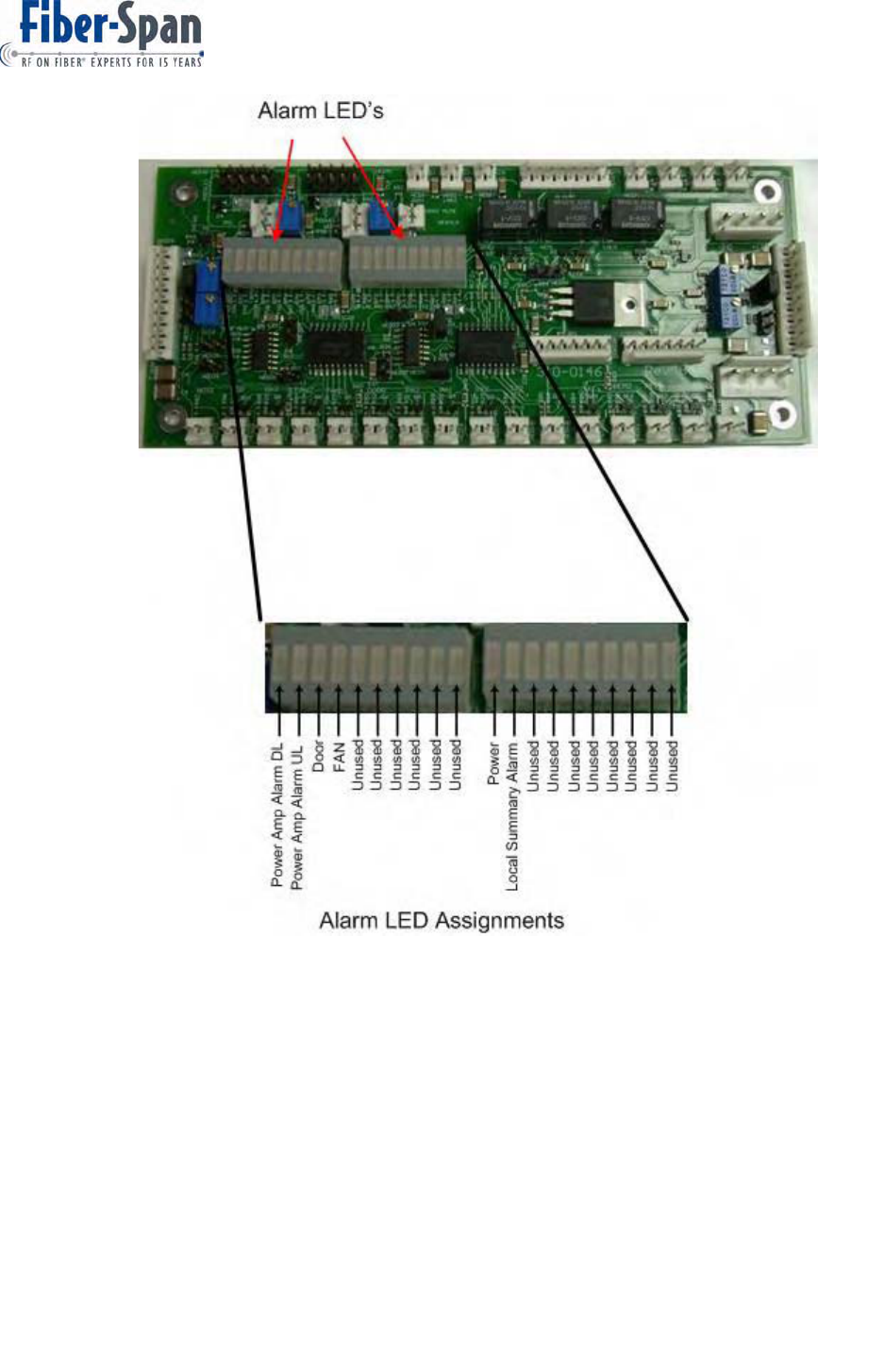
UHF Headend Repeater Unit
User Manual Ver. A
Document ID: FS31H-4X -USR Page 16 of 32
A summary of these alarms is connected to an 8-pin male Switchcraft connect on the bottom of
the HRU. The pin out of the male Switchcraft connector is shown in the following diagram.
Page 16 of 29
30
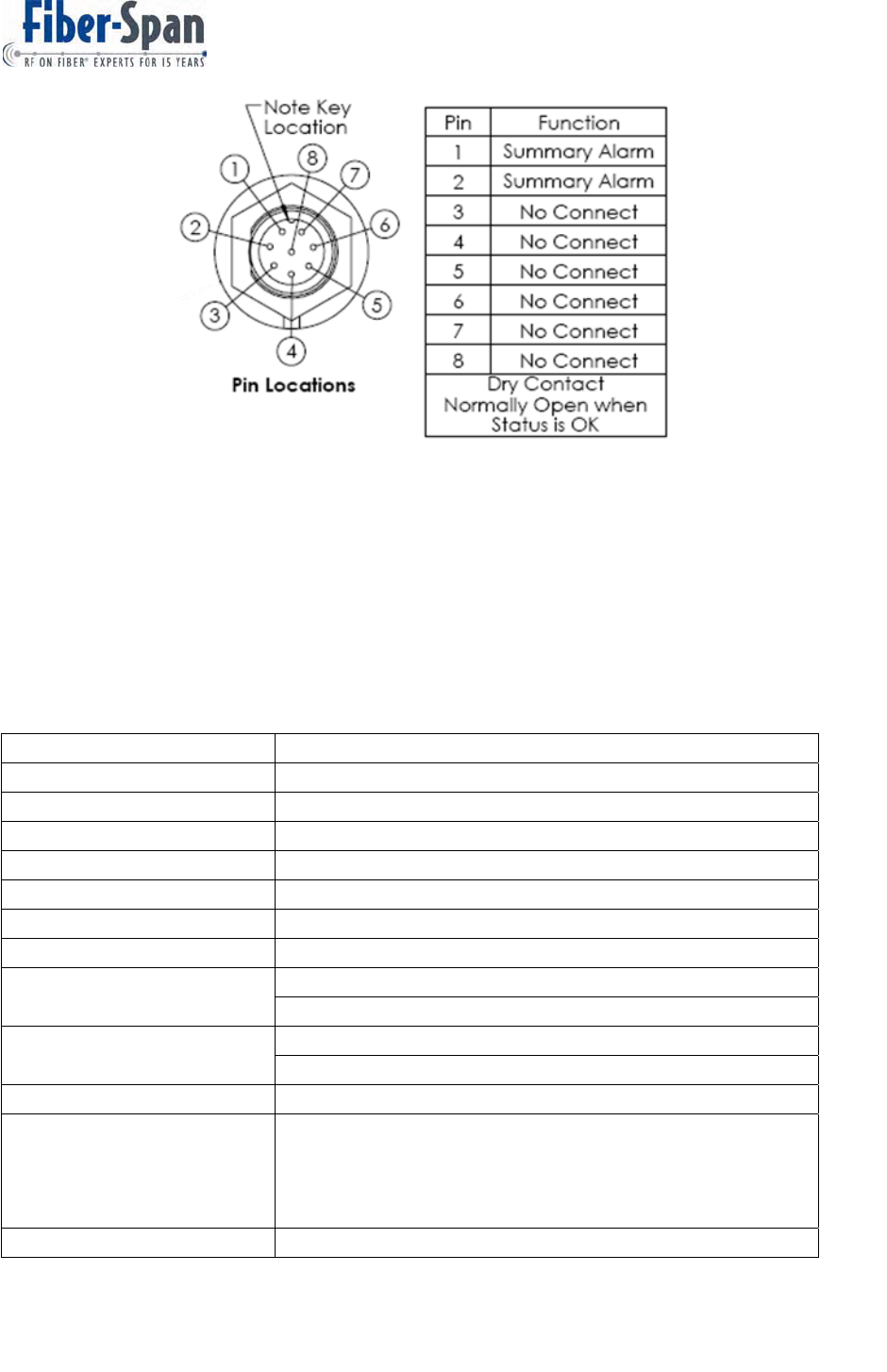
UHF Headend Repeater Unit
User Manual Ver. A
Document ID: FS31H-4X -USR Page 17 of 32
When there is an alarm condition, there is a short circuit between pins 1 and 2. This is a
summary alarm for any alarm in the HRU.
3.4 Power Supply
The power utilized in the HRU is capable of supplying 150W at 28V DC. The power amplifier
draws approx. 90W at 28V DC. This is to ensure that there is additional headroom for other
minor active components like LNA’s and the Alarm Motherboard.
3.5 Specifications
Frequency Range Downlink 457 - 462 MHz, Uplink 464 - 469 MH
Gain 40 dB to 70 dB in 2dB steps
OIP3 54dBm
Noise Figure 7dB
Power per Channel Refer to Derating Table
Pass Bandwidth See Frequency Arrangements
Input/Output VSWR < 2.0:1
Connectors N- Female
Dimensions (WxHxD in.) 20x20x9 (Refer to following table)
Weight (lbs) 100lbs (20”x20”x9”)
Mounting Method Wall-mount Enclosure
Alarms (dry contact) 1. Downlink Amp RF Power Output
2. Uplink Amp RF Power Output
3. Door Alarm
4. Fan Alarm
MTBF 5 Years
Page 17 of 29
30
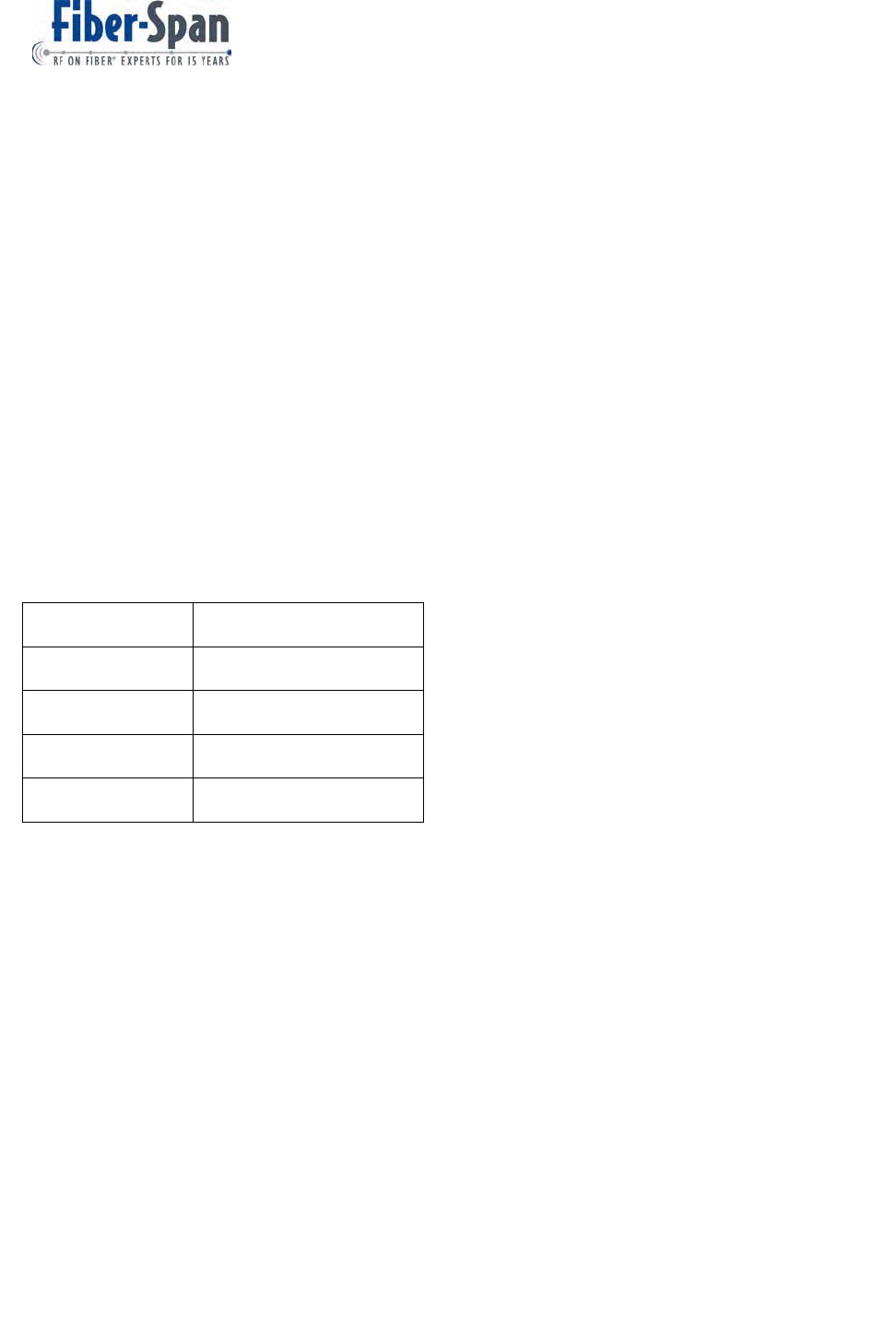
UHF Headend Repeater Unit
User Manual Ver. A
Document ID: FS31H-4X -USR Page 18 of 32
UHF HRU Frequency Arrangements and Enclosure Sizes
Passband Tx-Rx Separation Enclosure Size
0.5 MHz 5 MHz 20”x20”x9”
1.2 MHz 3 MHz 24”x24”x9”
3 MHz 5 MHz 24”x24”x9”
3 MHz 9 MHz or 10 MHz 20”x20”x9”
5 MHz 9 MHz or 10 MHz 20”x20”x9”
The following table provides the power per RF channel. At these carrier levels, the RF amplifier is
operating in the linear range.
UHF HRU Derating Table
# of RF Channels Power per Channel (FM)
1 36 dBm
2 33 dBm
4 30 dBm
8 27 dBm
Page 18 of 29
30
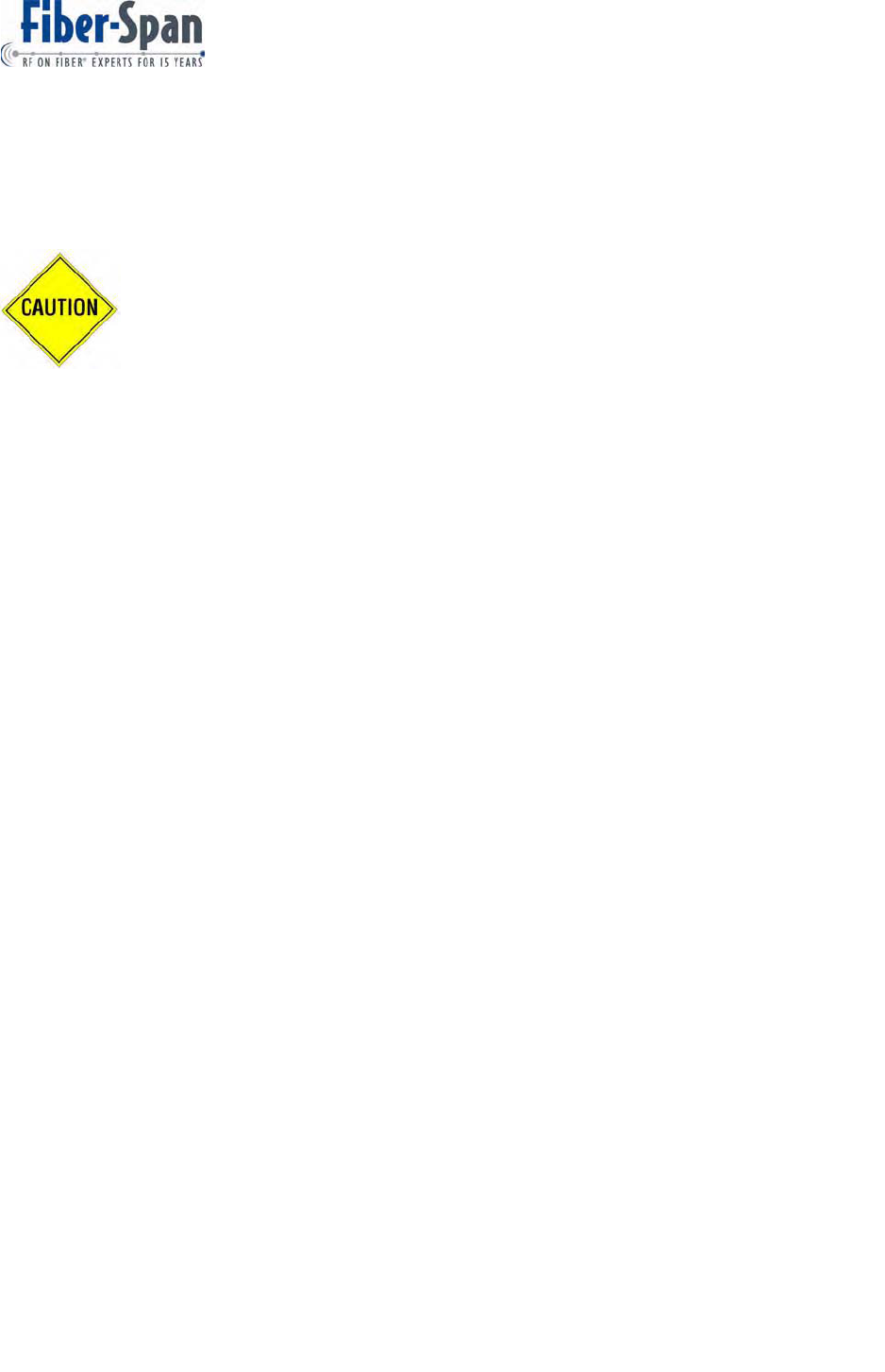
UHF Headend Repeater Unit
User Manual Ver. A
Document ID: FS31H-4X -USR Page 19 of 32
4.0 Setup Procedure
4.1 Cautionary Notes
Before the unit can be connected to the DAS and powered on, the following
cautionary notes must be observed.
Before powering the unit on, it is imperative to measure the downlink composite
power level at the antenna port. If the downlink signal level is excessive (>-24dBm), additional
external attenuation will be required at the antenna port.
All output ports must be terminated with a 50Ohm load capable of handling 20W of power
before the HRU is powered on. Alternatively, the HRU can be connected to the in-building
system assuming the connections are 50Ohm with acceptable VSWR (<2.0:1). This will prevent
damage to the unit.
For HRU’s with fans, the fans must not be blocked to allow heat energy to escape the
enclosure. An HRU with a blocked fan will have a much lower MTBF.
4.2 Contents
With the purchase of any HRU the following are included when shipped:
o HRU Product
o HRU User Manual
o Test Data Sheet showing factory set levels
o Outline Drawing
The dimensions for a standard configuration is 20”x20”x9” as shown below. The exception to
this configuration is the HRU with a 3 MHz passband and a 5 MHz Tx/Rx separation which is
24”x24”x9”.
Page 19 of 29
30
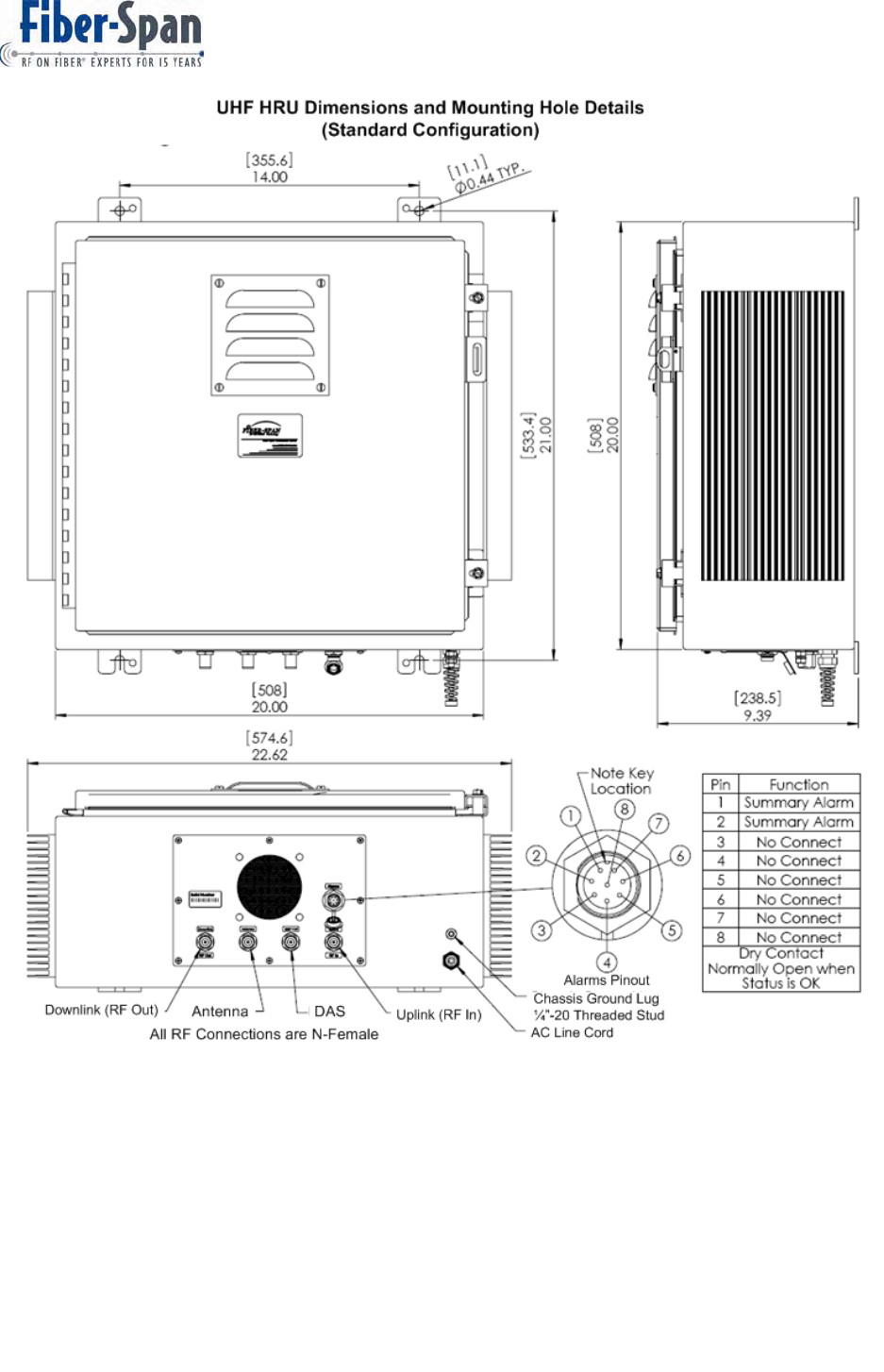
UHF Headend Repeater Unit
User Manual Ver. A
Document ID: FS31H-4X -USR Page 20 of 32
Outline Drawing #1 – Wall-mount version
Page 20 of 29
30
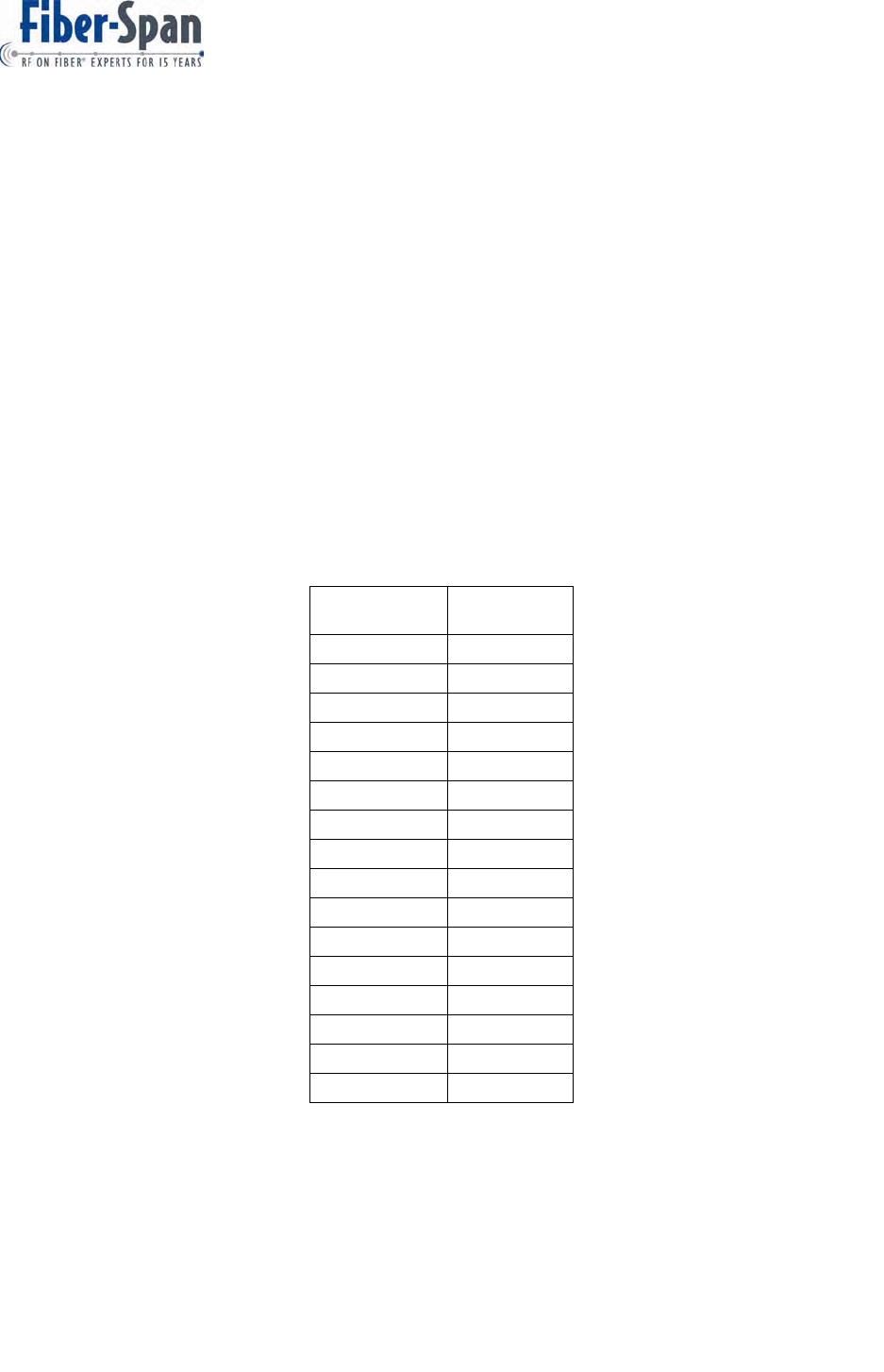
UHF Headend Repeater Unit
User Manual Ver. A
Document ID: FS31H-4X -USR Page 23 of 32
The factory set output power is 36dBm. The gain of the amplifier is defined as follows:
Gain = 36dBm – Input Level
Gain is also defined as follows:
Gain = 80dB – Att1 – Att2
Putting the two equations together:
36dBm – Input Level = 80dB – Att1 – Att2
Att1+Att2 = 44 + Input Level
The attenuators can be set simply knowing what the input power level is into the HRU
downlink port. For e.g. if the input power level is -20dBm,
Att1+Att2 = 44 + (-20dBm) = 24dB
Consult the following table regarding the dial indicator setting.
Dial
Indicator
Attenuation
0 30 dB
1 28 dB
2 26 dB
3 24 dB
4 22 dB
5 20 dB
6 18 dB
7 16 dB
8 14 dB
9 12 dB
A 10 dB
B 8 dB
C 6 dB
D 4 dB
E 2 dB
F 0 dB
In this case, Att1 would be set to “3” and Att2 would be set to “F”.
This gain setting excludes the losses from the filters and is handled in the next step.
Page 21 of 29
30
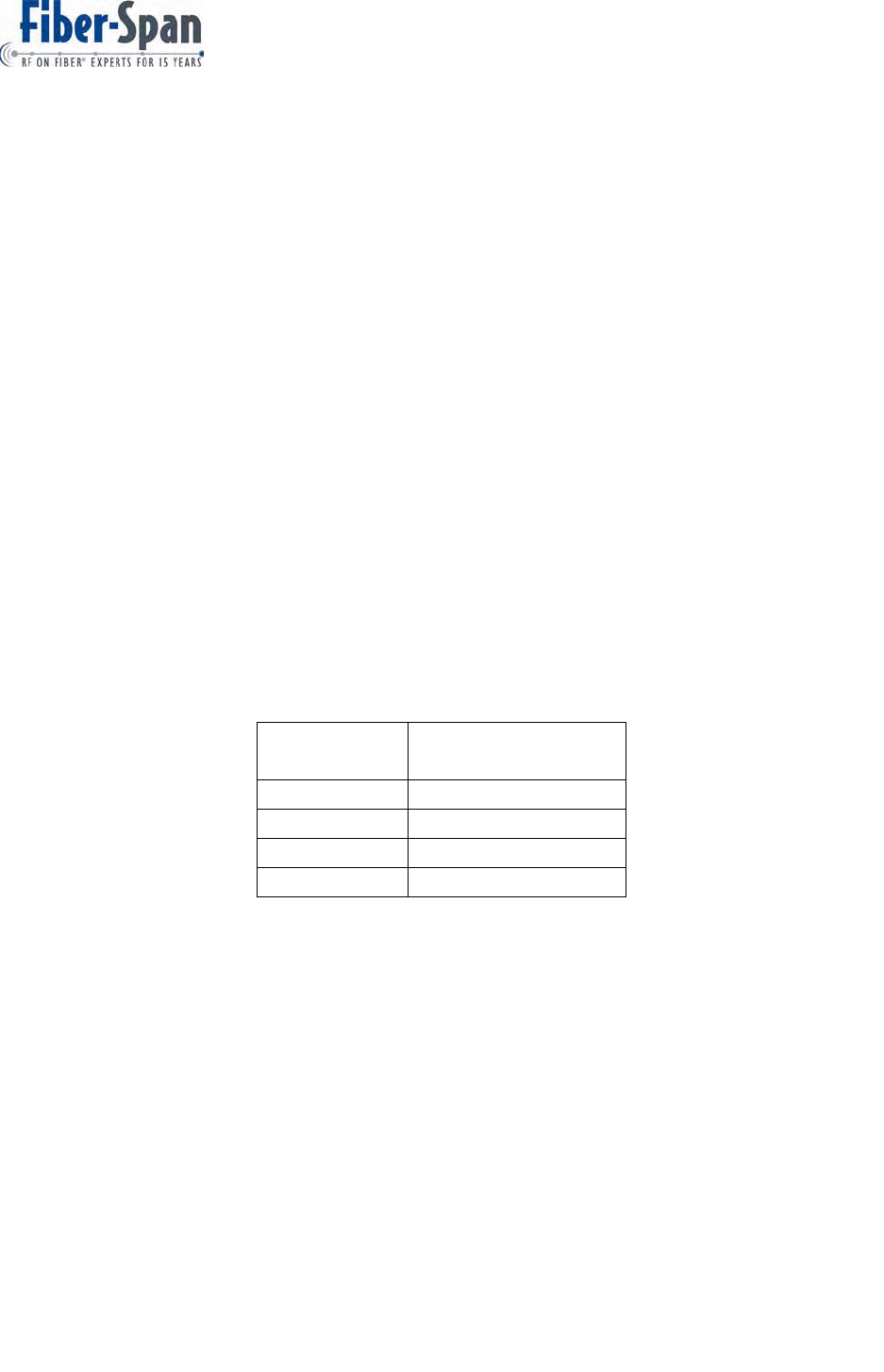
UHF Headend Repeater Unit
User Manual Ver. A
Document ID: FS31H-4X -USR Page 24 of 32
3) Set the final output level of the HRU while connected to the antenna port. To obtain a
higher output level, the attenuators can be carefully adjusted one click at a time carefully
taking note of the composite output power.
4.4 Uplink Setup
Generally in most applications, the uplink gain is set equal to the downlink gain. In most non-
commercial UHF applications, the coverage enhancement system is downlink limited. This is
due to the fact that the portable handset transmits at a much higher signal level than a
commercial unit (1W to 5W). A portable handset does not have the capability to reduce transmit
power like a commercial cell phone, so care must be taken when setting the uplink gain. The
uplink gain is set based on what the worst case highest and lowest uplink signal into the HRU
from the DAS. The uplink amplifier has 10dB of uplink ALC range.
4.5 De-rating Table
After the downlink gain and the output composite power is set, the power per channel must be
measured to ensure that the downlink signal level high enough at the DAS port is sufficient to
provide coverage.
The following table summarizes the power per channel for FM type modulation schemes. At
these carrier levels, the RF amplifier is operating in the linear mode.
UHF HRU Derating Table
Number of RF
Channels
Power per Channel
(FM)
1 36 dBm
2 33 dBm
4 30 dBm
8 27 dBm
4.6 Power Amp ALC Threshold Setup
The following procedure illustrates how the ALC is set for the downlink. The same can be done
for the uplink:
1) Set the downlink gain to maximum on the HRU by setting the step attenuators to 0dB
(position F).
2) Inject a -60dBm carrier into the antenna port with an RF signal generator.
3) Measure the output signal level with a spectrum analyzer and a 20dB pad capable of
20W.
Page 22 of 29
30
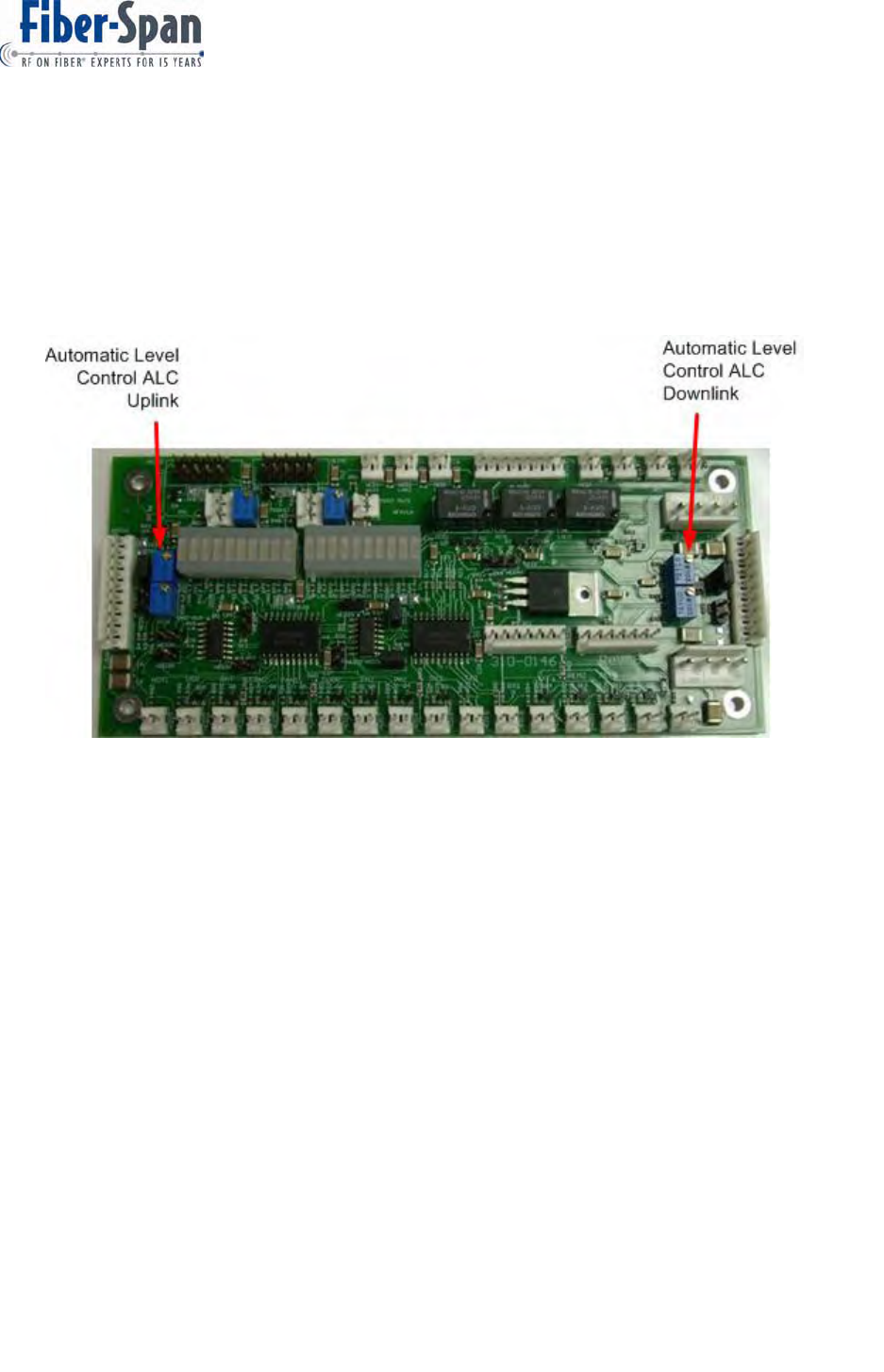
UHF Headend Repeater Unit
User Manual Ver. A
Document ID: FS31H-4X -USR Page 25 of 32
4) Continue to increase the input signal level with the signal generator until the output
signal level does not increase. This is the current setting of the ALC.
5) To change the ALC setting, turn the potentiometer on the control board as shown below
for the appropriate power amplifier.
6) The ALC setting is 31-41dBm at the DAS port or antenna port.
4.7 Power Amp Forward Power Output Alarm Threshold Setting
The Forward Power Output threshold setting is used to set an alarm when the output power
level reaches 3dB above the ALC level. This is normally set at the factory. To adjust this to a
different level, follow the following steps;
1) Set the downlink gain to maximum on the HRU by setting the step attenuators to 0dB
(position F).
2) Inject a -60dBm carrier into the antenna port with an RF signal generator.
3) Measure the output signal level with a spectrum analyzer and a 20dB pad capable of
20W.
4) Continue to increase the input signal level with the signal generator until the required
output level is reached.
5) Adjust the potentiometer on the alarm motherboard as shown below until the alarm LED
comes on.
Page 23 of 29
30
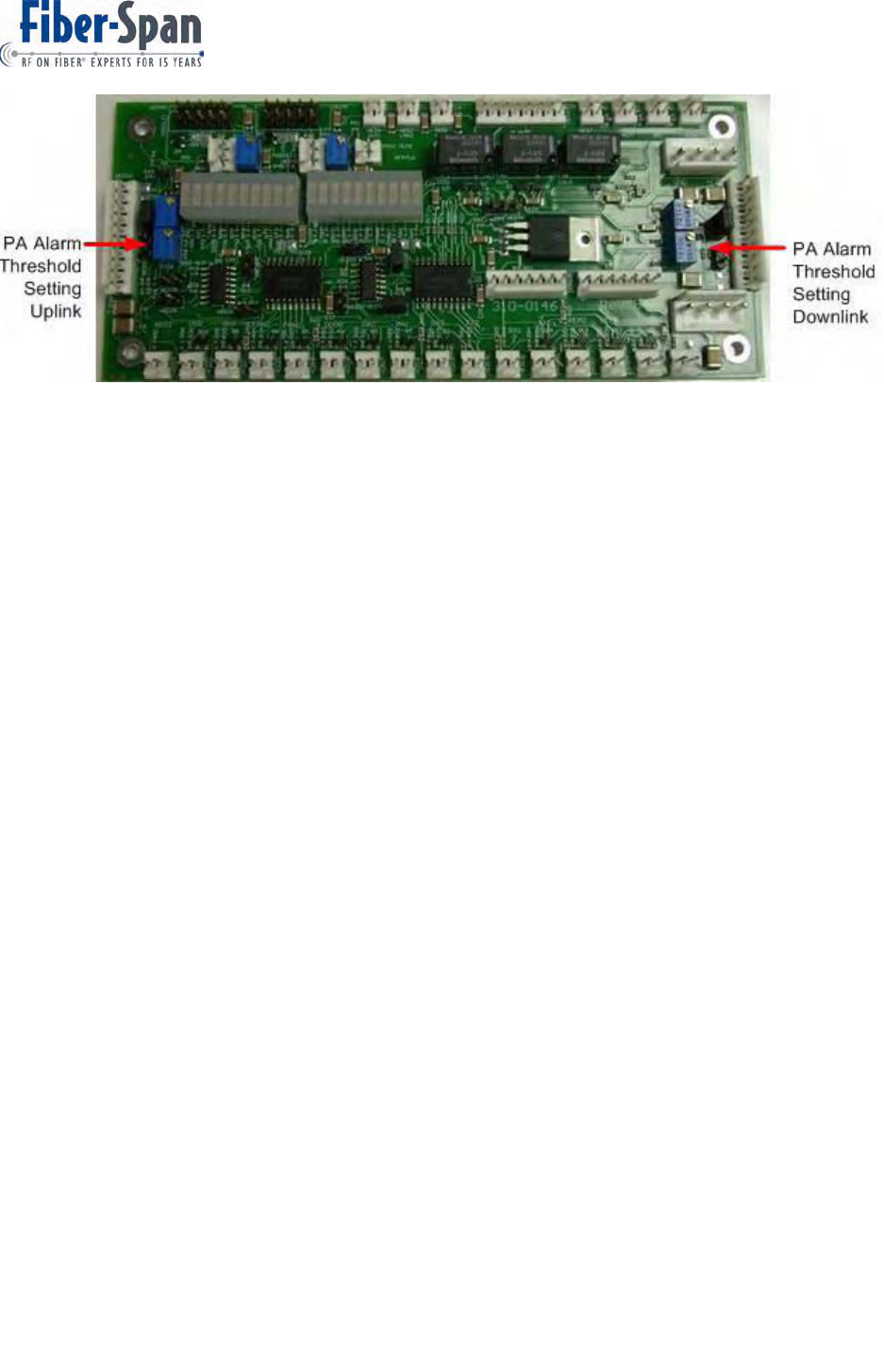
UHF Headend Repeater Unit
User Manual Ver. A
Document ID: FS31H-4X -USR Page 26 of 32
6) The alarm threshold has a range of 11-41dBm at the DAS or Antenna port.
Page 24 of 29
30
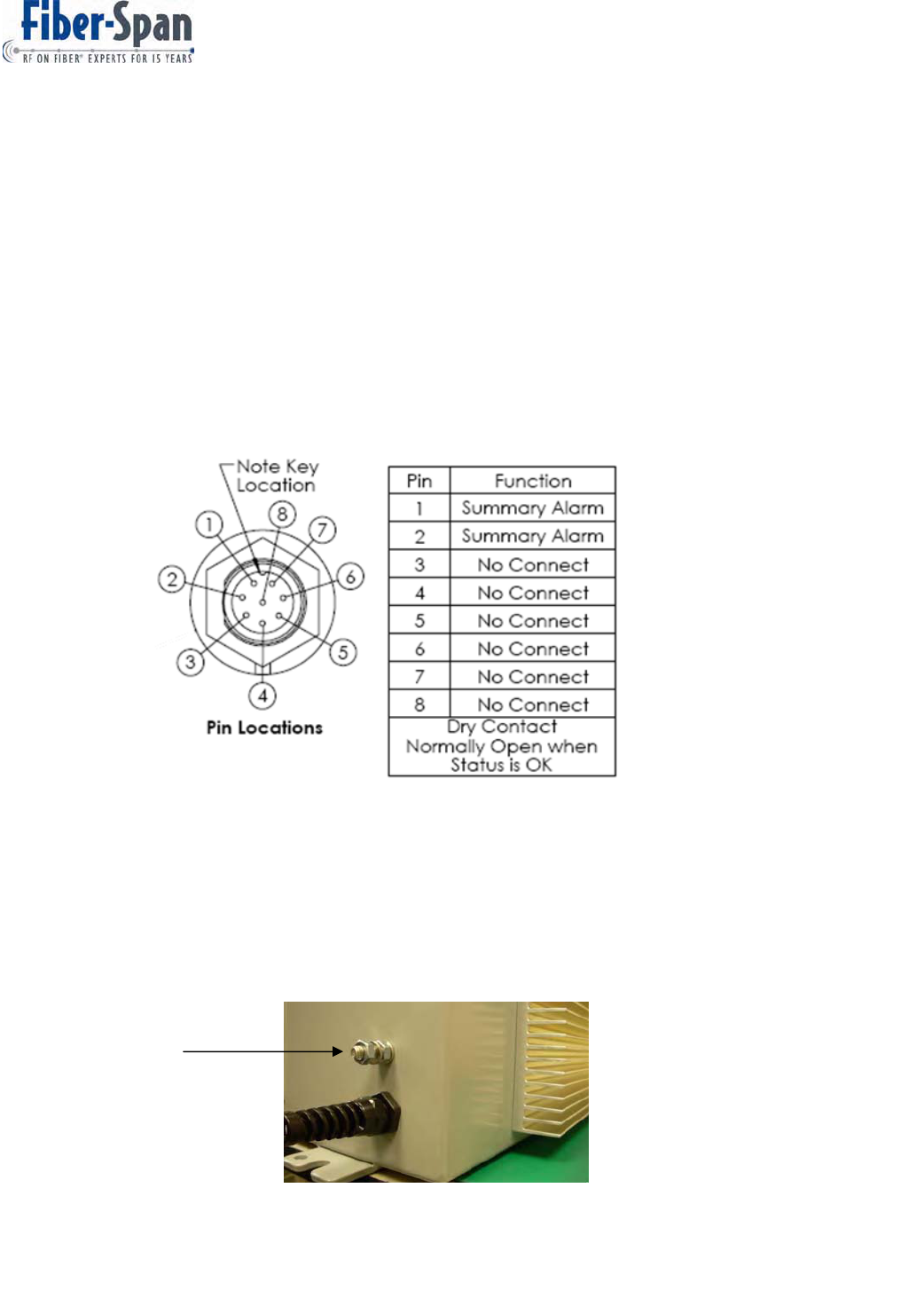
UHF Headend Repeater Unit
User Manual Ver. A
Document ID: FS31H-4X -USR Page 27 of 32
5.0 Installation Procedures
Fiber-Span’s HRU is made to operate in a controlled environment such as a telecom room. It is
recommended that the temperature inside the room does not exceed +50°C and be above -5°C.
The humidity must be 10% to 95%.
5.1 Connectorization
The HRU is supplied with N-female connectors on all RF ports. It is highly recommended that 3
ft jumper cables be used to connect the HRU to coaxial cable, otherwise the RF ports will strip.
If the HRU is being used as a simple BDA and the downlink port and uplink port are unused, it is
recommended that these ports be terminated with a 50 load.
The alarm port has an 8-pin male switch-craft connector and is shown below.
5.2 Grounding
The HRU comes with a grounding lug.
An illustration of the ground lug is shown below.
Grounding Lug
Page 25 of 29
The HRU comes with a grounding lug. Unscrew the nut, remove the lock washer from the ground bolt of the RF BDA located
on the bottom of the unit. Insert a 1 hole lug 6 gauge ground awg green THHN wire to the bolt. Slide the lock washer and nut to
the bolt, tighten nut until lock washer is compressed. Situate the RF BDA 10 feet away or less from room ground bar. Connect
the other end of the ground wire to the building room ground bar.
30
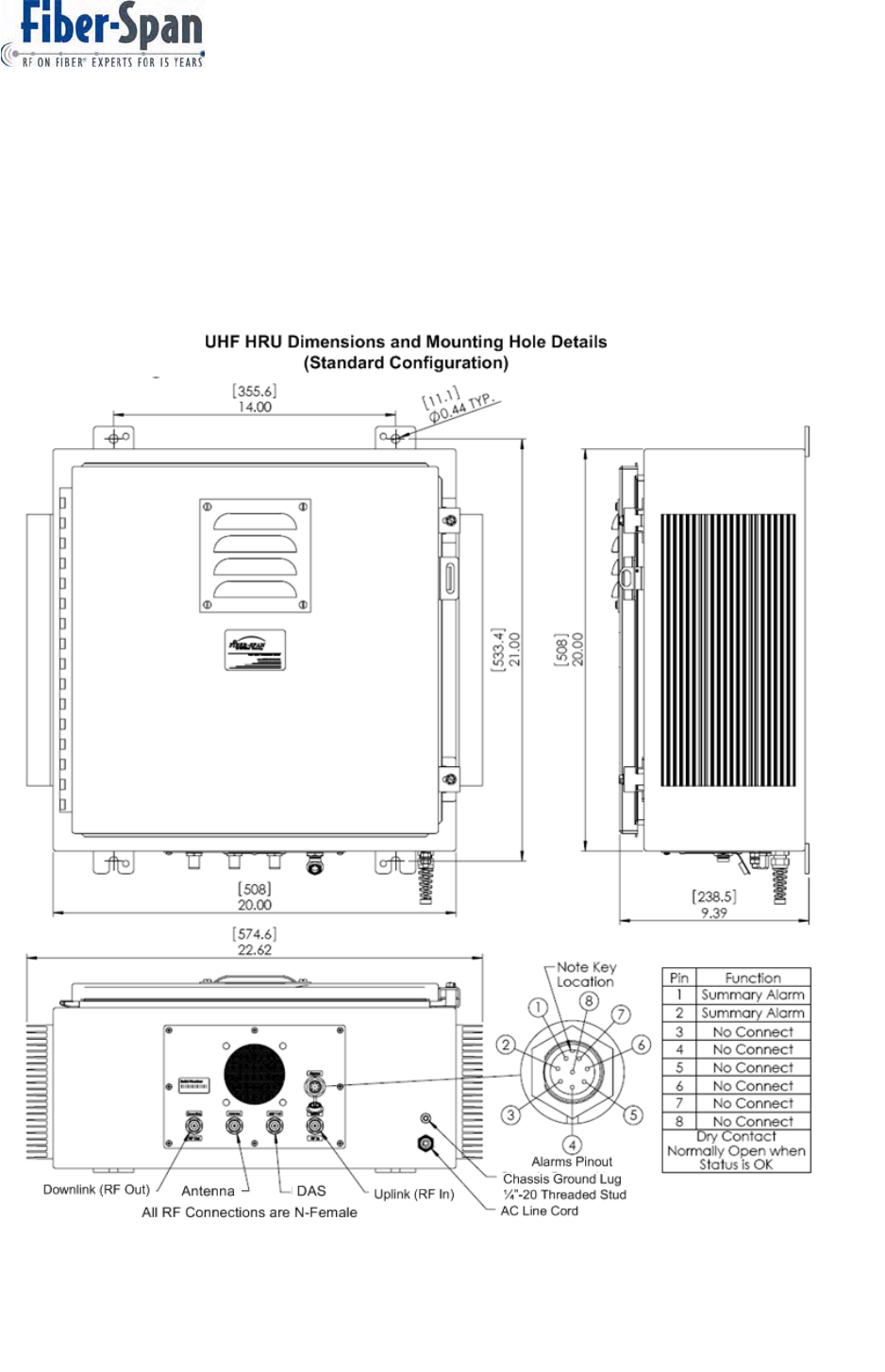
UHF Headend Repeater Unit
User Manual Ver. A
Document ID: FS31H-4X -USR Page 28 of 32
Surge protection is highly recommended for the coaxial feed to the external donor antenna to
prevent damage to the unit during a direct lightning strike.
5.3 Adequate Anchors required
Bolts of adequate strength are required to mount the HRU which weights approx. 100lbs for the
standard 20”x20”x9” configuration and 150lbs for the 24”x24”x9”. A total of four (4) bolts are
needed to mount the HRU. The bolt patterns for the HRU’s are shown in the following
diagrams.
Page 26 of 29
30
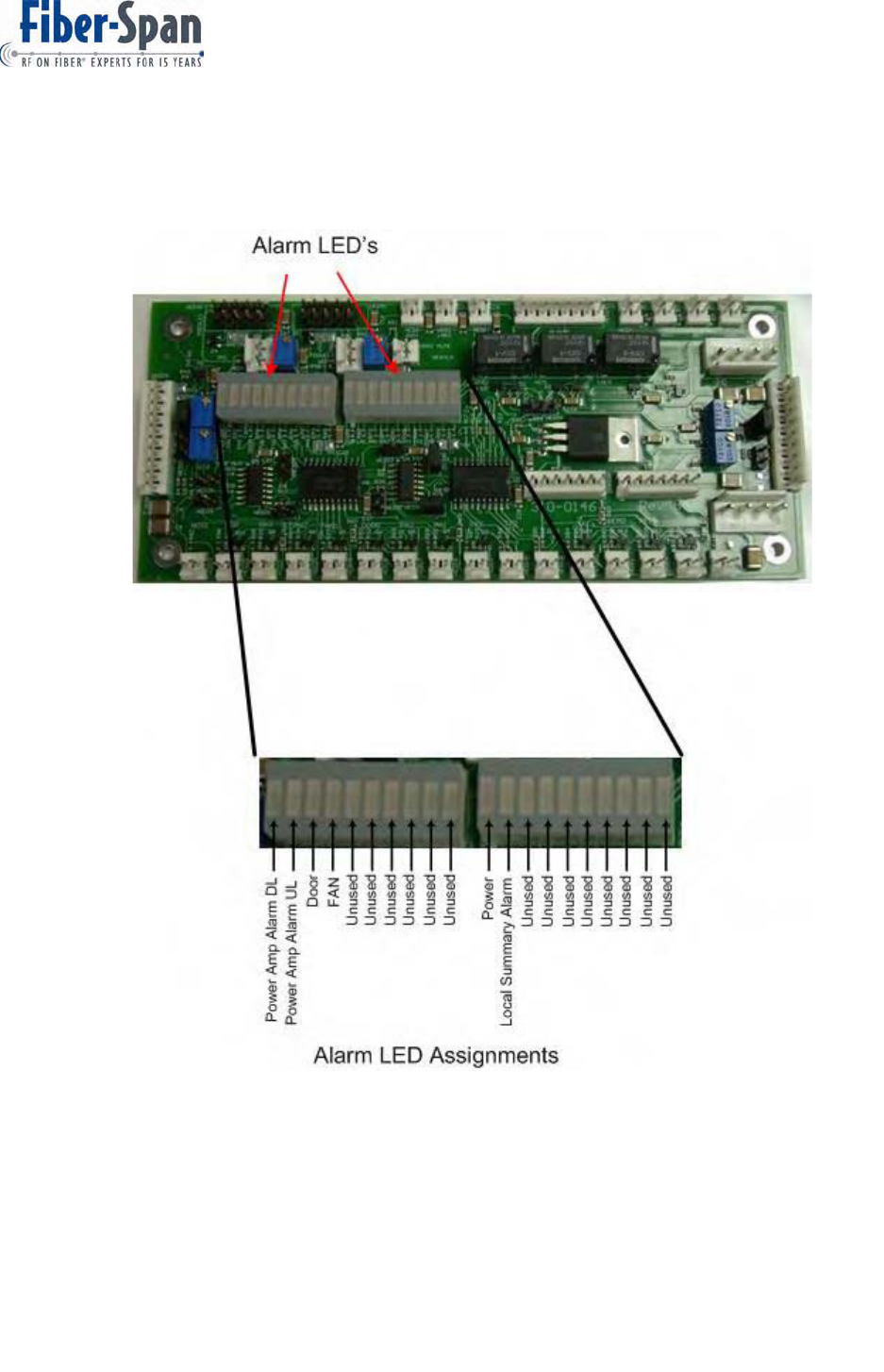
UHF Headend Repeater Unit
User Manual Ver. A
Document ID: FS31H-4X -USR Page 30 of 32
6.0 Troubleshooting
In order to trouble shoot the HRU, the alarm lights must be observed as shown in the alarms
section.
Based on the LED’s, if corrective action does not bring the unit into normal operation by
reducing gain or reducing the input signal level, the unit is most like faulty. It is recommended
that the gain of the power amplifier be verified by connecting it with a signal generator and
spectrum analyzer as shown below after powering the unit off:
Page 27 of 29
30
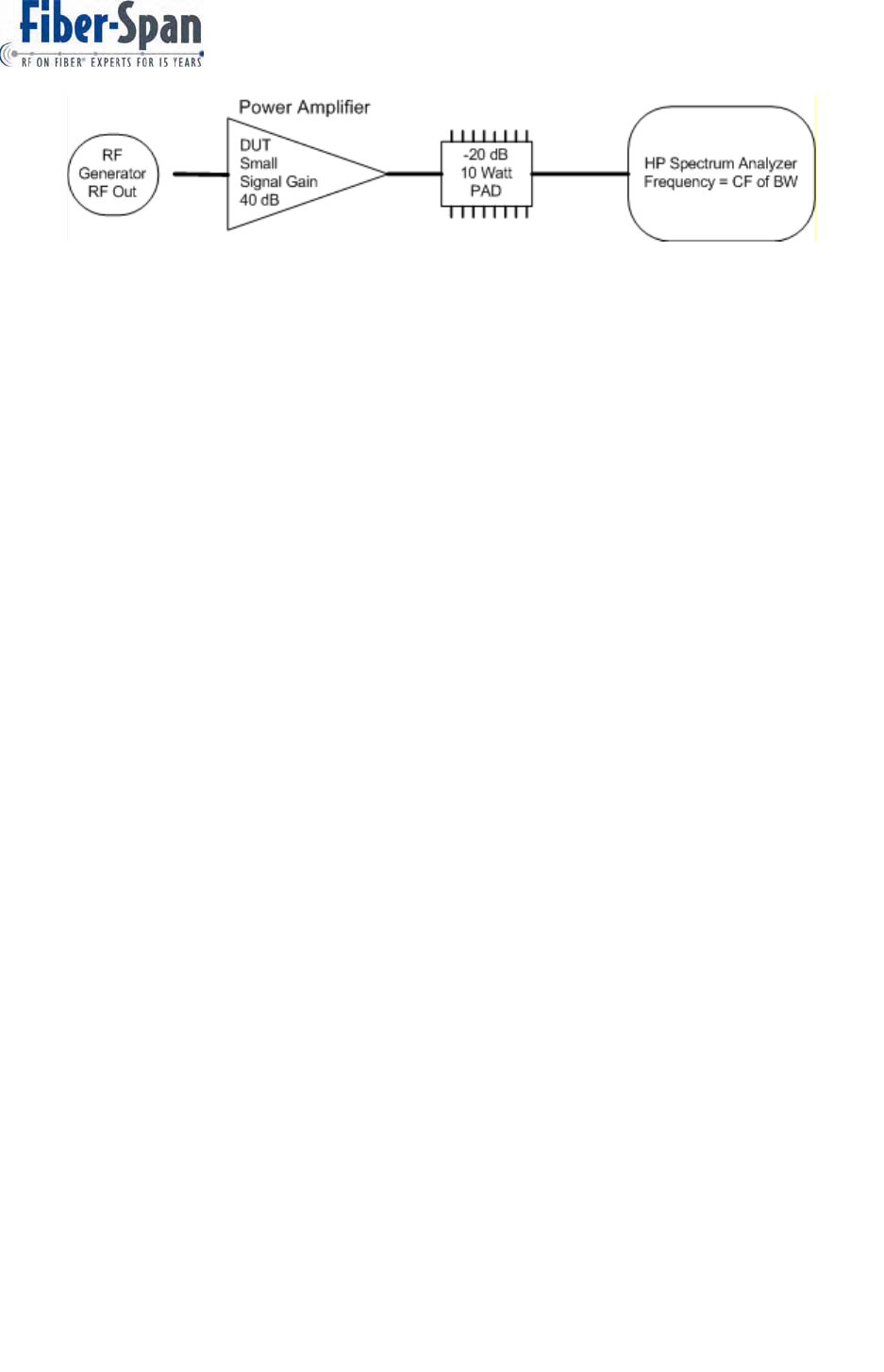
UHF Headend Repeater Unit
User Manual Ver. A
Document ID: FS31H-4X -USR Page 31 of 32
A 20dB (10W) attenuator is needed to ensure the RF output does not damage the spectrum
analyzer. Most analyzers can accept a 20dBm composite RF input signal level. However, Fiber-
Span recommends verifying the specifications of your analyzer prior to connecting to the Power
Amplifier.
Set the signal generator and spectrum analyzer to the center frequency of the downlink/uplink
frequency spectrum.
Set the RF output level of the signal generator to -40dBm. Verify that the gain of the amplifier is
approx. 46dB typical by measuring +6dBm at the RF output taking into account the 20dB RF
pad. If the gain is much different than 46dB, then the power amplifier must be faulty and needs
replacement.
The ALC setting of the power amplifier is verified by increasing the input signal level of the
signal generator. When the output signal level does not increase as the input signal level
increases, the ALC level has reached the threshold. If the threshold needs adjustment, refer to
the procedure in section 4.
6.1 Power LED Light
When the power supply has the correct DC output voltage, the LED will stay lit on the
motherboard. Otherwise the LED will be off.
6.2 Door Lights
When the door is opened, one of the LED’s on the alarm motherboard will be lit.
6.3 Amplifier Alarms
An amplifier alarm will trigger under the following condition: The RF power amplifier output
power has exceeded the ALC and the PA alarm threshold LED is on. At the same time, the
ALC LED on the amplifier will also be lit. It is recommended that the gain be reduced.
6.4 Fan Blockage
It is highly recommended that the fan screens be cleaned where the HRU is installed in very
dusty or newly constructed environments. Clearing the fan screen will improve air circulation
which will allow the unit to operate at a lower temperature increasing the MTBF of the unit.
Page 28 of 29
30

UHF Headend Repeater Unit
User Manual Ver. A
Document ID: FS31H-4X -USR Page 32 of 32
7.0 Warranty Information
The HRU carries a standard warranty period of one (1) year unless otherwise indicated on the
shipping package as noted in the purchase order agreement.
7.1 Warranty Limitations
The warranty is limited to the repair or replacement of the defective product. Fiber-Span will
decide which remedy to provide for defective components at its own discretion. Fiber-Span
shall have a reasonable time after determining that a defective product exists to repair or
replace the problem unit. The warranty applies to repaired or replaced products for the balance
of the applicable period of the original warranty or ninety (90) days from the date of shipment of
a repaired or replaced component, whichever is longer.
The Fiber-Span standard warranty does not cover products which have been received
improperly packaged, altered, or physically damaged. For example, broken warranty seal,
labels exhibiting tampering, physically abused enclosure, broken pins on connectors, any
modifications made without Fiber-Span authorization, will void all warranty.
7.2 Limitations of Damages
The liability for any defective product shall in no event exceed the purchase price for the
defective product. Fiber-Span has no liability for general, consequential, incidental or special
damages.
7.3 Return Material Authorization (RMA)
No product may be returned directly to Fiber-Span without first getting an approval from Fiber-
Span. If it is determined that the product may be defective, you will be given an RMA number
and instructions in how to return the product. An unauthorized return, i.e., one for which an
RMA number has not been issued, will be returned to you at your expense. Authorized returns
are to be shipped to the address on the RMA in an approved shipping container. It is suggested
that the original box and packaging materials should be kept if a defective product needs to be
shipped back to Fiber-Span. To request an RMA, please call 908-754-0646.
Page 29 of 29
30
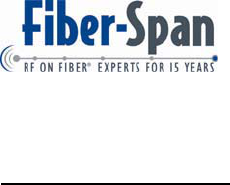
UHF Headend Repeater Unit
User Manual Ver. A
Fiber-Span ŏ111 Corporate Blvd., South Plainfield, New Jersey 07080
Tel: 908.754.0646 ŏFax 908.754.0647 ŏwww.fiber-span.com
Appendix A
FCC requirements
To comply with FCC RF exposure compliance requirements, the following antenna
installation and device operating configurations must be satisfied: A separation
distance of at least 1 meter distance must be maintained between the antenna of this
device and all persons. RF exposure compliance may need to be addressed at the time
of licensing, as required by the responsible FCC Bureau(s), including antenna co-
location requirements of 1.1307(b)(3). Maximum permissible antenna gain is 9 dBi for a
1 meter distance. Maximum permissible antenna gain is 15 dBi for a 2 meter distance.
(Equipment manufacturers shall provide proper values for antenna gain).
Document ID: FS31H-4X –USR Page 30 of 30